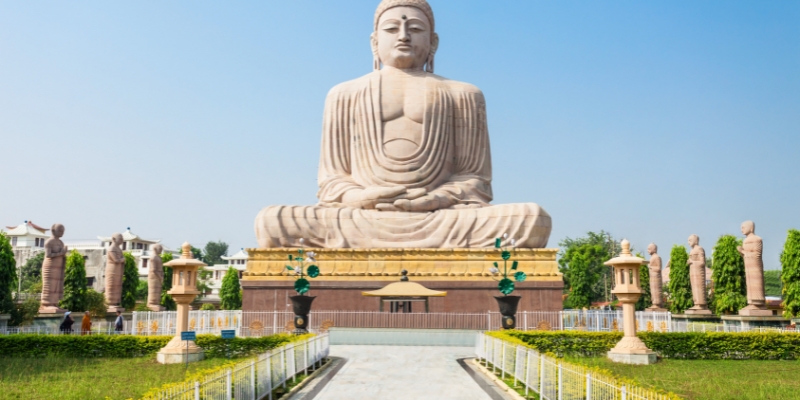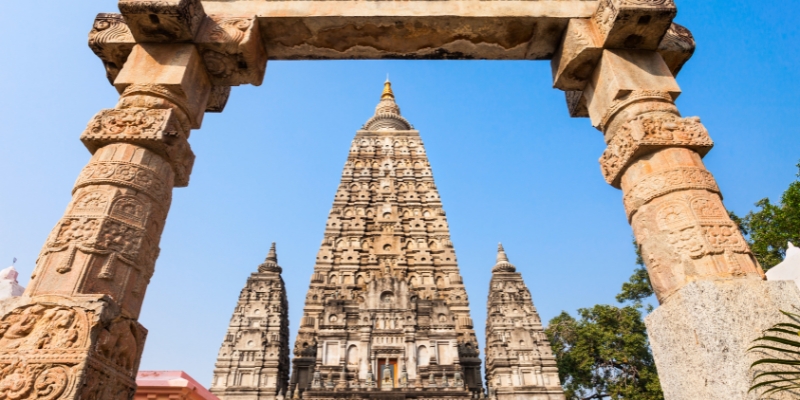Advertisement
History and legacy abound in Bihar, India's heartland. Its historical importance gives the state pride and offers tourists many experiences. This article looks at Bihar's rich history and architectural wonders that have survived.
Buddhism, education, and millennia-old civilizations are linked to Bihar's history. Buddhism, intellectuals, and kingdoms have made their imprint on this area. You'll learn about Bihar's rich culture and why pilgrims and history buffs come from across the globe as we tour its historical monuments.

Nalanda University:
Ancient knowledge center Nalanda University is revered in education history: a vibrant study and intellectual exchange hub from the 5th century AD. Monastic buildings, libraries, and lecture rooms remain from Nalanda's previous greatness. These walls hosted ancient intellectuals studying philosophy and mathematics. The educational and Buddhist dissemination legacy of Nalanda is excellent. Pilgrims and history buffs visit these remains to honor this wisdom and spiritual center.
Mahabodhi Temple, Bodh Gaya:
The Mahabodhi Temple at Bodh Gaya, the "Mecca of Buddhism," is exquisite. This hallowed location is where Prince Siddhartha Gautama became the Buddha. The UNESCO World Heritage Site temple is an example of old Indian architecture. Visitors feel spirituality from its towering spire and elaborately carved façade. Bodh Gaya attracts pilgrims, monks, and curious tourists who meditate under the Bodhi tree and enjoy the temple's peacefulness. Spiritual energy is tangible as history and religion blend.
Vikramshila University
Vikramshila University in Bhagalpur was renowned during the Pala dynasty's 8th century AD rule. The institution advanced Buddhist studies, philosophy, and debate with its spectacular viharas (monasteries) and sizeable central stupa. It was where academics and students met to learn. Beyond its ruins, Vikramshila represents India's academic brilliance and lively intellectual atmosphere. Today, it is appreciated by individuals seeking Indian philosophy and education foundations.
Rajgir:
Rajgir, an old hamlet in Bihar's lush hills, has shaped the region's history. As Magadh's capital, Rajgir saw civilizations grow and fall. History is preserved in its buildings, temples, and monasteries. Buddhists venerate Griddhakuta Hill, also known as Vulture's Peak, where Buddha delivered many significant lectures. Venuvana Monastery, an old Buddhist monastery with beautiful architecture, symbolizes Rajgir's spirituality. The Son Bhandar Caves show the town's religious variety, including Jainism.
Patna Sahib Gurudwara:
Patna Sahib Gurudwara, also known as Takht Sri Harmandir Sahib, is a spiritual hub for Sikhs. Guru Gobind Singh, the tenth Sikh Guru, was born there. Sikhs worldwide respect the gurudwara's exquisite architecture. People visit Patna Sahib to pay homage and experience the gurudwara's spirituality. It's a religious, cultural, and historical gem of Sikh history.
Bhagalpur:
Bhagalpur, formerly Bhagaddatta, has a rich history. Once a significant commerce hub, it attracted merchants from far and wide. The present Vikramshila Setu bridge symbolizes Bhagalpur's trade and commerce history. Nearby Colganj Rock Cut Temples showcase the region's historic art and architecture. Bhagalpur's history shows Bihar's longtime commercial and cultural center status.
Pawapuri:
Jains worldwide revere Pawapuri, a peaceful Bihar town. After fasting to transcendence, Lord Mahavira, the 24th Jain Tirthankara, reached Nirvana. A lotus-pond-side temple, Jal Mandir, is the town's most treasured attraction. The temple's white marble construction and peaceful surroundings invite meditation and devotion. Pawapuri is revered and historic for Jain pilgrims and people interested in India's spiritual legacy.

Sher Shah Suri Tomb, Sasaram:
Sasaram's Sher Shah Suri Tomb honors the 16th-century Afghan ruler controlling a vast kingdom. For his administrative skills and infrastructural development, Sher Shah's mausoleum is a masterpiece of Indo-Islamic architecture. The tomb's red sandstone grandeur and symmetry mirror medieval architecture. For those interested in Indian architectural traditions, it is a crucial historical landmark since it influenced Mughal architecture.
Gaya:
Gaya, in central Bihar, has great historical and spiritual importance. Hindus, Buddhists, and Jains have pilgrimaged there for ages. Gaya is well known for Lord Buddha's enlightenment beneath the Bodhi tree. The Mahabodhi Temple, an emblem of peace and enlightenment, attracts pilgrims. Another famous temple, the Vishnupad Temple, is claimed to have Lord Vishnu's footprint. Gaya's spiritual and historical appeal draws tourists seeking a deeper connection to India's past.
Gaya's architectural wonders and cultural variety reflect its history beyond religion. The city represents India's history, as empires fall and varied cultures merge. Visitors become part of a historical continuity that has created the city's character and inspires spiritual awakening and historical understanding as they explore its elaborate temple carvings and perform rituals beside the holy river Phalgu.
Munger:
Munger, a Ganges River city, is rich in history. Education and military training have made Munger a study and martial arts hub. Fort Munger, an old fortress, symbolizes the city's strategic significance. Visitors learn about Munger's importance in guarding against invaders and maintaining regional security as they explore its well-preserved walls and architecture.
The Munger Ganga Bridge, a historic railway bridge, crosses the Ganges. Over time, this bridge has helped the city flourish and connect. Munger history includes intellectual success, military might, and cultural variety. As tourists explore its historical monuments and engage with residents, they discover layers of history that have created the city's character and contributed to Bihar's rich past.
Bihar Sharif:
Bihar Sharif, a historical and cultural town, is unique to Sufi Muslims. The shrine of Sufi saint Sheikh Sharfuddin Ahmed Yahya Maneri is a spiritual retreat for worshippers. This town is known for its Sufi shrines, notably Makhdum Shah Sharif-ud-din Yahya Maneri. These shrines honor the town's centuries-old Sufi tradition of spirituality and devotion.
In addition to its religious significance, Bihar Sharif has beautiful mosques and tombs in Mughal and Indo-Islamic styles. The town's history is tied to Sufi saints and regional culture. Visitors to Bihar Sharif enjoy the town's history, architecture, and the shrines' spirituality.
Historical Significance of the Ganges River:
The Ganges River, known as the "Ganga," symbolizes India's spiritual, cultural, and historical legacy. Its historical importance is ingrained in millions of hearts, sustaining traditions, ceremonies, and stories. The Ganga's history includes ancient civilizations, holy ceremonies, and countless pilgrims' spiritual journeys.
The Ganges River has shaped the lives of its people throughout history. It has seen empires build and fall, religions grow, and India's culture evolve. Hindus bathe in the Ganga, which purifies. The Ganges River has seen historical events, cultural interactions, and environmental changes that have shaped India's past, not only religiously.
Conclusion:
In conclusion, Bihar's historical sites are live reminders of its colorful history and rich cultural legacy. These sites tell tales of civilizations, enlightenment, and religion. Exploring Bihar's historical riches allows you to journey through time, discover the past, and see how history, spirituality, and architecture interact. Bihar's historical sites invite history buffs, spiritual seekers, and curious travelers to explore India's rich past.
Advertisement

Most Charming Small Towns in Sweden

The Transformative Power of Travel on Your Personality and Health

Exploring Venkateswara National Park: A Comprehensive Guide

Madhya Pradesh, Architectural Marvel- Best for Joyful Vacations

Sariska Wildlife Sanctuary: Everything you need to know

Best Family Resorts in Texas 2023

Exploring Jaipur's Markets: Your Ultimate Shopping Destination

Journey Through Time: Historical Places in Bihar

Big Bus Sydney Hop On Hop Off Tour: An Overview

Guide to the Glowing Beach in Maldives: When and How

Igloo Stay In Manali 2023: An Ultimate Guide
